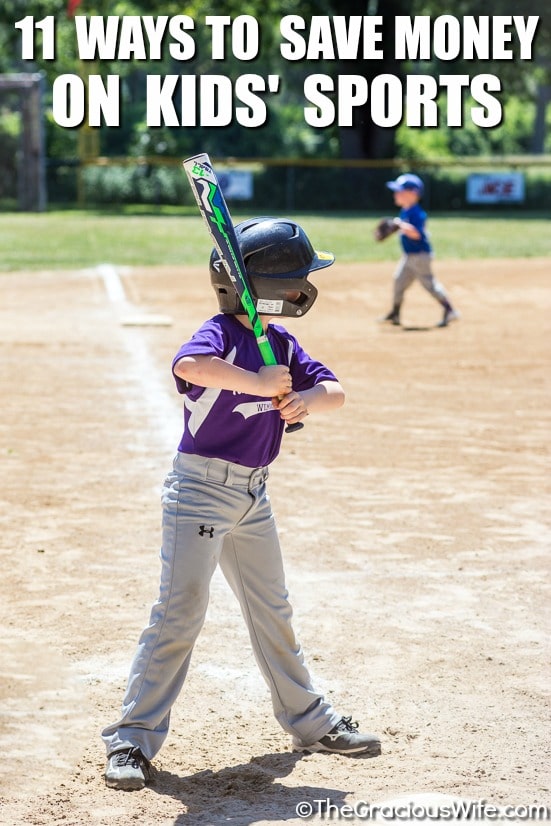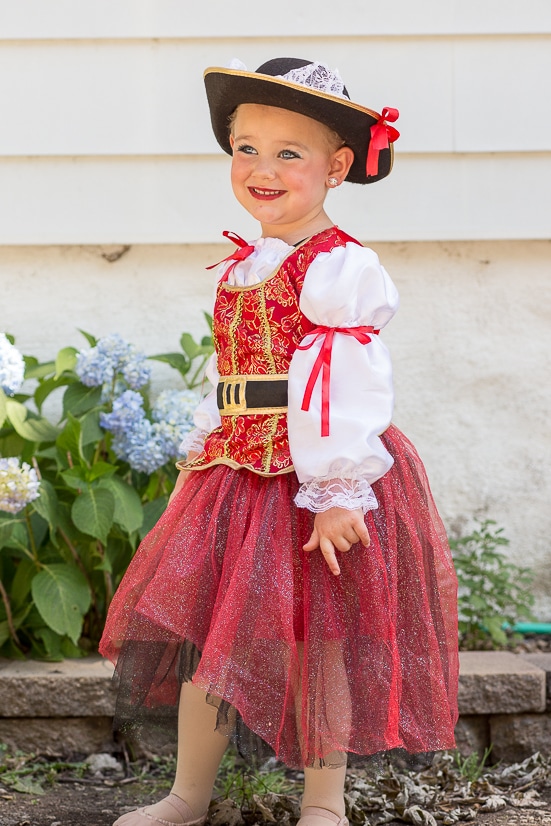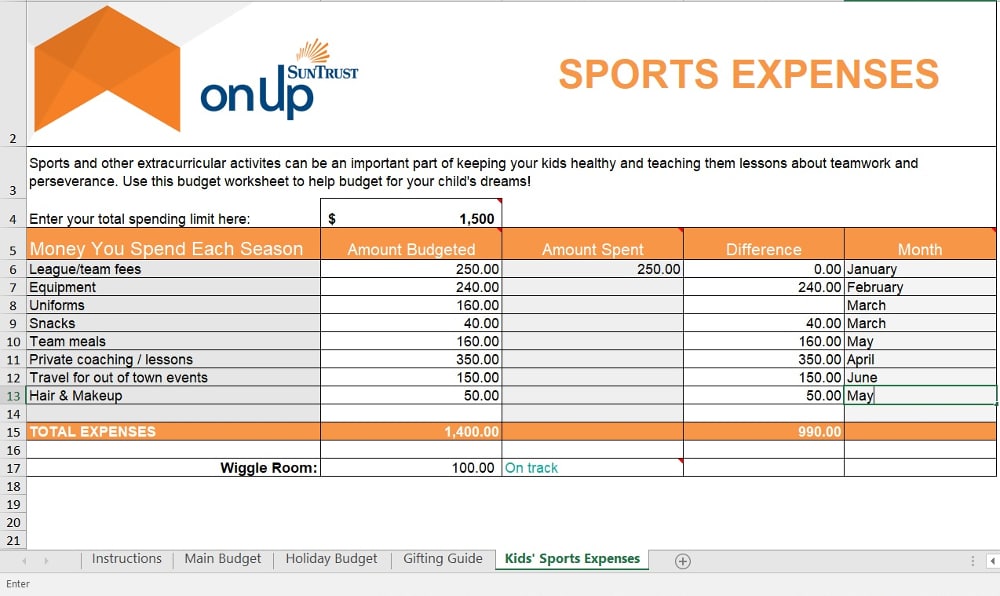This post was sponsored, and paid for, by SunTrust. All opinions are my own.
Want to let your kids do sports, music, or art but are tight on money? Find out how to afford kids' sports and activities on a budget with these 11 simple ways to save on kids' activities and sports!

Ways to Save on Kids' Activities and Sports
Spring is coming! And with it a whole new sports season! Watching your kids find their passion is exciting, and playing sports benefits kids, too. Kids learn teamwork, determination, cooperation, and discipline. While there's nothing that makes you feel more proud than watching your child step up to the plate, turn a perfect pirouette, or score their first soccer goal, it can be stressful to find a way to fit these sports and activities into your budget.
If you have a child in sports or extra-curriculars, then you already know all about the price tag attached. With registration fees, league dues, equipment, uniforms, travel, and more, you can expect to see the cost climbing quickly. While you might be willing and eager to make sacrifices so that your child can achieve their dreams, you can do it the smart way by starting with a plan.
I'm excited to partner with SunTrust today to talk about some simple ways to save on kids' sports and activities to help take the financial stress out of achieving your child's dreams.

11 Ways to Save on Kids' Sports and Activities
1. Choose one sport or activity at a time. We allow our children to pick one sport or activity per season or 2-3 sports and activities per year. This limits both the amount of money and the amount of time we're spending on activities.
2. Buy used gear. With kids growing so fast, we have to get new gear and equipment for them almost every season. To cut costs, we try to buy used when we can. There are usually used sporting goods stores in your area (The ones in our area are called Play It Again Sports, but if there's not one near you, you can google "used sporting goods" and stores will pop up!). Also, consider checking the Facebook marketplace and Craigslist. While you're there, you might also sell your old equipment to help pay for the new! For more expensive equipment, such as golf clubs, you might also consider renting equipment, especially if your child is just testing out the sport to see if they like it.

3. Volunteer. Most organized sports clubs will give you a discount if you agree to donate your time. Things like being a coach, cleaning up and maintaining the field, and working in the concession stand are all good places to start.
4. Carpool. Save money on gas and a little time too by setting up a carpool arrangement with other team members' families.

5. Stick to necessities. There are lots of sports items that kids might like to have (or that you might like them to have) that aren't completely necessary, such as batting gloves or goalie gloves for very young players, their own personal helmet when the team provides them one for free, expensive water bottles, headbands, and more. Buy only what your child needs to save money. Skip the extras and buy more generic brands when possible.
6. Pack budget-friendly healthy snacks. Instead of sugary, expensive energy or sports drinks, opt for simple, inexpensive water, bonus points if you pack it in a re-usable container. Send fruits, like bananas, mandarin oranges, or grapes, or easy-to-eat veggies, such as baby carrots, celery sticks, cherry tomatoes, or cucumber slices, instead of pre-packaged chips, snacks or candies, all of which cost a little more and will add up over time.

7. Join school or community teams. Most schools offer extra-curricular activities and sports at little-to-no cost to parents. Also, generally speaking, park district leagues and community center leagues like the YMCA are less expensive than private league fees.
8. Ask friends for their old gear. If your friends have kids that are a little older or bigger than your own, ask them if they'd be willing to part with some of their old gear. They might ask for a little money in return (probably to help with their own costs!), but their asking price will likely be even cheaper than used sporting goods stores, and they might even let you have them for free if they were planning on throwing out or donating the equipment!
9. Skip the "professionals." Private lessons can add up, especially when the trainer or coach is a seasoned professional. Cut costs by asking a local college or high school student to give your child lessons. They'll generally charge less and are likely being coached themselves, so they'll know the professional techniques without the professional price tag.
10. Stay local. Travel teams are going to be more expensive than local teams. Even if league fees are similar between a traveling and a local team, consider that you will have to factor in transportation, possibly airfare, and even hotel costs if your child is on a traveling team. If you do decide you want your child on a traveling team, look into discount hotel websites and flying rewards programs.

11. Budget, budget, BUDGET! The most important tip I have to help you afford the costs of kids' sports and activities is to make a budget and stick to it! I'll show you mine below, and break it down for you. But first, some tips to get you started.
- Break down your budget into individualized expenses.
- Be realistic. Under-estimating can put a strain on your household budget or even push you into debt. Set a budget that accounts for actual expenses that you can realistically stick to.
- Split your budget up. You don't need to plan on making one huge deposit or withdrawal. Break up the expense, and set a little money aside, even during months that you don't have any purchases to make or fees to pay. We usually put aside $200-$250 per month for expenses year round. We have 3 children, and they each do two sports every year (though they've been asking about music lessons, so we might bump it up to three activities! Ah!), so your monthly budget might be a little more or a little less depending on how many kids you have or how many activities they're in.
- Write it down! There is just no way I can keep track of everywhere my kids need to be for school and activities, plus everything else that a working mom needs to remember, PLUS a household and kids' sports budget all in my head. When you write it down, you won't forget, which will help you save money and stick to your budget. Thankfully, SunTrust has this free budgeting tool on onUp.com that I use and you can use too. It even has a special section for kids' activity expenses, and it autofills into your household budget, making this tool soooo easy to use. Head HERE to download the SunTrust budget worksheet for yourself.
As promised, I'm giving you a sneak peek into our budget, I'll break it down for you.

Okay. So here's our budget for sports as it stands. This budget only goes about 5 months in the future for us because I'm self-employed so my income can vary by a lot from month to month, and my husband is a firefighter so his schedule can, and does, change frequently, which also affects our income. Planning too far in advance for us is a waste of time because we know that we'll have to do it over. But we do like to look ahead a little bit to make sure we're setting aside money if we need to or maybe even picking up extra work or shifts if it looks like we have need to. You can plan as much in advance as you're comfortable. If you're salaried with a steady job, you can probably sit down and make a generalized budget for a whole year! But it's up to you.
So the section pictured above is the "Kids' Sports Expenses," which you can see in green at the bottom of the screenshot. I actually did the very top line where it says "Enter your spending total" last because I wanted to make our itemized expense list first to make sure we had a little just-in-case wiggle room (which lowers stress levels in my world!)
So, we have $250 for league fees, which accounts for both our boys' registration fees that we paid for already in January. We also paid $125 for our daughter's recital fees, but I didn't include that in this budget because we actually budgeted for it in December since we knew it was coming up. Then we have $240 in equipment. This accounts for new bats because the boys are moving up a league, baseball gloves and helmets for the same reason, extra tights for dance, and new ballet shoes because our daughter is on the edge of out-growing hers. For uniforms, our registration fee includes the price of team shirt and ball caps, so we just need to buy cleats and gray baseball pants. Then we also have a costume fee for our daughter's dance recital.
We don't spend that much on snacks or team meals, which only happen after the last game or after recital. Private lessons are just my daughter's dance lessons, which add up to about that much over a year. Travel is just for gas for games and practices since our kids are on local teams. And then we fork out a nice chunk for hair products and dance makeup for recital.
Our kids are still pretty young, so unfortunately, the costs are going to go up as they age and possibly get more serious about their sports.
You also might notice that I have a month typed out next to the expenses. When you type in a month, the worksheet will auto-fill the amount into the household budget page. I circled it in red below.

My biggest recommendation for budgeting for kids' sports is to just set aside money every month. Once you know your big total figure with wiggle room, you can divide that number by 6 months or 12 months, and just keep putting money aside for it so you're not scrambling when you need it! We have a checking account that we call our "checking savings account." We basically just transfer money that we need to set aside but won't use right away into that account, and we never spend from that account unless it's for what we put it there for in the first place!
We are waist-deep in this budgeting stuff right now, trying to manage our normal expenses, plus pay off all of our debt, save money, go on a family vacation, and pay for our kids' sports and activities. Sometimes it can get overwhelming and stressful, but that's the very reason that budgeting is important. And SunTrust's free budget worksheet on onUp.com is an amazing resource to have on hand. It's easy to use adapt for your family and expenses, and it helps you know that you're staying on track! It's a true sanity-saver!
So let's get going! Fill out your own budget worksheet for this coming sports season. Screenshot it and tag me on Instagram @thegraciouswife, so we can share notes and tips!
For more tips on taking the stress out of kids' sports and activities, head over to onUp.com and read these articles! With the right planning, you can be confident that it’s possible to support your children’s athletic dreams.
This post was sponsored, and paid for, by SunTrust. All opinions are my own.







Leave a Reply